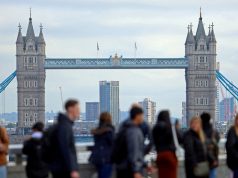England is deep into its third lockdown, yet the daily tally of new COVID cases and deaths remains sickeningly high. As Chris Whitty, the country’s chief medical officer, said recently, more needs to be done to bring the pandemic under control.
Masks, which when worn correctly are highly effective in reducing transmission, are already compulsory in indoor public places in the UK. There is talk of making them mandatory in some outdoor settings, as is currently the case in Spain. Perhaps the UK should follow France and require people who are jogging or cycling to wear masks if they are unable to maintain a physical distance from pedestrians.
There are many arguments against such a measure. The risk of transmitting coronavirus outdoors is an order of magnitude less than indoors, according to a study that has yet to be published in a scientific journal. Exercising outdoors is one of the few freedoms people in England still have. When jogging or cycling, contacts tend to be rare and fleeting, so would not meet the UK’s official definition of a “close contact” for which one needs to spend 15 minutes closer than two metres – though this time period can now be notched up in a series of shorter encounters throughout a day.
The World Health Organization (WHO) is adamant that: “People should NOT wear masks when exercising, as masks may reduce the ability to breathe comfortably”; and “Sweat can make the mask become wet more quickly which makes it difficult to breathe and promotes the growth of microorganisms.” The WHO recommendation is to maintain at least one-meter physical distance from others.
But there are also strong arguments for challenging the WHO’s advice. The main one being that the NHS is truly overwhelmed for the first time in its 70-year history because of the rise in COVID hospital admissions. All possible measures must be taken to reduce these numbers.
Over half of all cases of COVID are acquired from people who have no symptoms at the time they pass it on. The 15-minute rule for close contact is arbitrary (based on custom and practice rather than empirical evidence). One-meter or two-meter distancing rules (which are derived as much from economic models of lost productivity as from scientific evidence of protection) do not mean that if people keep within these distances, they are safe. The rules mean only that people farther apart are less likely to infect one another.
Ethical argument
Masks work mainly by protecting other people. Pedestrians passed by a relatively young and fit jogger or cyclist include people who are elderly or otherwise more vulnerable to COVID and its complications. If there is a risk of transmission, there is surely an ethical argument to mask up.
The exhaled breath of someone who is exercising vigorously has a different composition and different aerodynamic properties to that of someone who is not. As we all know, a passing jogger breathes heavily, generating exhalations with much higher momentum than occurs with resting breathing.
In cold weather, clouds of moisture-laden air become visible as the jogger exhales – and these clouds spread much farther than those exhaled by walkers. Formal studies of the aerodynamics of breathing confirm that heavy breathers emit turbulent gas clouds in which are suspended droplets and microdroplets of different sizes, some of which are carried considerably farther than two meters.
Several coronavirus variants have been shown to be more transmissible than the original virus. Because each infected person is now likely to infect between 30%-60% more people than previously, an unlucky inhalation in the vicinity of a passing jogger – itself a rare possibility – is now much more likely to lead to an escalating series of secondary cases, one or more of which could be fatal.
Contrary to some information sources, there is no evidence that casual jogging in a mask (as opposed to vigorous exercise undertaken in a tight-fitting respirator with the specific goal of pushing one’s physiology to extremes) leads to significant metabolic harm. And in particular, blood oxygen levels are not reduced when exercising in a cloth or medical mask.
The WHO is correct that masks may reduce the ability to breathe comfortably, though masks made of materials (such as multi-layer muslin or a muslin-flannel combination) that have low resistance but high filtration capacity will reduce this problem. Varying your exercising route may allow the mask to be safely removed for some sections – for instance, on reaching a park. A wet mask can be replaced with a spare dry one carried for the purpose.
A final reason for wearing masks when exercising near others is the message of social solidarity it conveys. The masked jogger or cyclist is saying both “the pandemic is still very serious” and “your safety is more important than my comfort or my lap time”. Instead of aggressive stand-offs between maskless exercisers and fearful walkers (which sometimes involves the potentially contagious act of shouting at close quarters), we could look forward to both parties exchanging a silent wave as they pass peacefully.
Almost all the research on masks and exercise has been undertaken in specialized laboratories. My own team is about to undertake a more pragmatic randomized controlled trial of the impact of different kinds of masks on exercise capacity, comfort and physiological markers in people taking outdoor exercise. We hope to report the results of that study later this year.![]()
Trish Greenhalgh, Professor of Primary Care Health Sciences, University of Oxford. This article is republished from The Conversation under a Creative Commons license. Read the original article.










